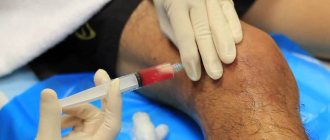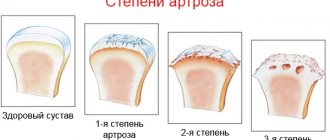In oncological practice, malignant neoplasms of soft tissues are quite common. Soft tissue sarcomas include malignant tumors localized in the synovial membranes, adipose, muscle, and epidermoid tissues. Among this type of sarcoma, in approximately 5-10% of cases, synovial sarcoma occurs, which is otherwise called malignant synovioma or synovioblastic sarcoma.
- What kind of pathology
- Etiology and pathological anatomy
- Localization and epidemiology of the tumor
- Clinical manifestations
- Sarcoma of the knee joint
- Ankle sarcoma
- Elbow sarcoma
- Shoulder sarcoma
- Soft tissue sarcoma
- Diagnostic methods
- Treatment of synovial sarcoma
- Forecast
What kind of pathology
According to the WHO definition, synovial sarcoma is a mesenchymal spindle cell malignancy that may have a tissue component with epithelial differentiation and the presence of a specific chromosomal translocation. This term first appeared back in 1895: it was introduced by the German doctor G. Simon. Since then, several hundred cases have been described, which have brought synovial sarcoma into an independent nosology.
Despite its name, the origin of malignant synovioma from elements of the synovial membrane has not been confirmed. It is believed that this tumor is a variant of primary carcinosarcoma. Some scientists believe that it comes from immature mesenchymal cells. There is even evidence that the tumor may be of neuroectodermal origin (due to the similarity in the expression of many genes of synovial sarcoma with a malignant tumor originating from the sheaths of nerve fibers). Be that as it may, research into the origin of the cells of this neoplasm continues, and in the WHO classification it is in the section of tumors with unclear tissue differentiation.
Etiology and pathological anatomy
The etiological factors of synovial sarcoma, like almost all cancers, are not completely clear. Precancerous conditions (schwannoma, dysplasia of tissues adjacent to the tumor), constant severe trauma to the joints, and the presence of foreign bodies are described as the possible causes of this type of sarcoma.
On microscopic examination of a biopsy specimen, a typical finding will be spindle cells with glandular-like structures. In terms of its morphological characteristics, malignant synovioma is extremely diverse: under a microscope, between poorly differentiated round-shaped cells (or resembling epithelium), you can see cracks or cavities that are filled with mucus-like structures. With a predominance of papillary elements like synovial villi, the tumor is classified as fibrous. The neoplasm may have many glandular cells, and then it is called cellular synovial sarcoma. If we consider the WHO data, then its experts divide this tumor into monophasic spindle-shaped and biphasic histological subtypes. Determining the exact morphological variant of the neoplasm is important for further prognosis.
Localization and epidemiology of the tumor
Synovial sarcoma is one of the most common malignant neoplasms of soft tissue among the adult population, and in children it is in second place (in terms of occurrence) after rhabdomyosarcoma. The tumor is most often found in young people aged 15 to 35 years, less often in patients under 50 years of age. After this age threshold, it practically does not occur. There is a slight predominance of the tumor in men.
The favorite location for synovial sarcoma is the soft tissue of the extremities, and sarcoma is localized in the joint area in 40% of cases. The knee joint is most often affected (30% of all joint locations), then the ankle joint, hip joint, and very rarely in the joints of the upper extremities. In most cases, metastases of synovioma (its malignant form) are found in the lungs (60-80%), in regional lymph nodes (up to 40%), and less often in the bones. Tumor metastasis occurs through the lymphogenous route.
Main activities
Diseases of the skeletal system:
- Bone sarcomas (osteosarcomas).
- Chondrosarcomas.
- Differential diagnosis of malignant and benign tumors.
- Tumor biopsy.
- Organ-preserving operations.
- Bone resection with endoprosthetics of large joints.
- Rehabilitation of patients after extensive organ-preserving surgical interventions.
- Conducting pre- and postoperative chemotherapy.
Soft tissue diseases:
- Soft tissue sarcomas.
- Differential diagnosis of malignant and benign tumors.
- Tumor biopsy.
- Organ-preserving case operations.
- Organ-preserving operations with plastic closure of the defect.
- Carrying out isolated perfusion of the extremities.
- Rehabilitation of patients after extensive organ-preserving surgical interventions.
- Conducting pre- and postoperative chemotherapy
Skin diseases:
- Melanoma.
- Squamous cell skin cancer.
- Basal cell skin cancer.
- Differential diagnosis of benign and malignant skin formations.
- Dermatoscopy.
- Biopsy.
- Removal of malignant skin tumors with plastics, displaced and free skin flaps.
- Sentinel lymph node biopsy.
- Regional lymphadenectomy.
- Carrying out isolated perfusion of the extremities.
Information about the department
The department has a capacity of 25 beds. Every year, the department performs about 250 osteoplastic operations, of which more than 100 operations are carried out in the scope of primary and revision endoprosthetics for primary and metastatic tumors, including endoprosthetics operations for rare localizations of tumor lesions of long tubular bones. Our specialists annually perform more than 200 operations to remove soft tissue sarcomas, including reconstructions of the defect. More than 200 operations per year are performed on patients with malignant skin diseases, with a variety of practice options.
Clinical manifestations
Symptoms of synovial sarcoma begin with the onset of pain in the area of the affected joint or soft tissue. If the tumor is dense and has calcifications, then the pain syndrome is more pronounced, and if it is cystic, the pain is not so noticeable. As the tumor progresses and surrounding tissues (vessels, synovial membranes, bone tissue) are involved in the oncological process, the pain increases. It is accompanied by a limitation in the range of both active and passive movements of the affected joint.
Upon palpation, a dense or soft (depending on the structure) formation is determined, sometimes without clear boundaries. The diameter of the tumor varies widely: from 2-3 to 20 cm. General symptoms characteristic of cancer of any location and origin increase quite quickly: periodic increase in body temperature, often to low-grade and febrile levels, malaise, weakness, loss of appetite, decreased weight.
Treatment of diseases
Such diseases are usually treated step by step and comprehensively. The duration of treatment depends on how advanced the disease is.
- The first thing that specialists need to do is to relieve the patient of pain.
- Then, you need to start normalizing blood circulation.
- After this, pay attention to how mobile the elbow joints are and achieve their complete normalization.
- Prevent muscle atrophy in the forearm area.
As for pain relief, doctors prefer phonophoresis or Bernard currents. In addition, a specialist can prescribe a novocaine blockade. Warming compresses are very effective, especially if they are based on camphor oil, vodka or the well-known Vaseline.
At home, you can resort to using a self-made propolis tincture. A honey massage or a bath with sea salt also helps.
Sarcoma of the knee joint
One of the very first and often dominant signs of sarcoma of the knee joint is local pain. With the rapid growth of the tumor (and the malignant course of sarcoma is most often aggressive), deformation of the knee joint appears, which can be distinguished visually: the appearance of a lump, redness, and then bluishness of the skin over the site of the lesion.
Impaired functionality increases as the tumor progresses: the range of movements decreases, the person begins to limp. Limiting physical activity brings only temporary relief. Sarcoma is characterized by constant pain, especially at night. As the malignant process spreads to the surrounding tissues, swelling increases, which often “drains” down along the blood, lymphatic vessels and nerves. Increasing pain and the inability to relieve it with non-narcotic analgesics indicate tumor growth.
Elbow sarcoma
A malignant neoplasm of this localization most often appears in the process of metastasis of other sarcomas. At the onset of the disease, pain gradually develops, and swelling can be visualized and palpated. Due to the fact that there is a powerful neurovascular bundle in the cubital region, the pain quickly acquires an acute, burning character. When the tendons and synovial membrane of the capsule are involved in the process, the motor function of the elbow joint is disrupted, then numbness of the limb and fingers increases when nerve fibers are damaged. Involvement of bone tissue in the process due to the aggressiveness of tumor growth leads to the frequent occurrence of pathological fractures.
Diagnosis of elbow joint edema in Moscow
The appearance of severe pain may not always occur with swelling of the elbow joint, so some patients postpone visiting a medical facility and use traditional methods of therapy and self-medication. The incorrect combination and use of therapy methods can lead to serious consequences; in addition, it is impossible to carry out diagnostics at home and make a diagnosis without special knowledge.
When a disorder is identified and a diagnosis is made, a set of diagnostic measures is carried out at the Yusupov Hospital:
- blood chemistry;
- Magnetic resonance imaging;
- radiography;
- puncture of the synovial sac.
If a patient develops swelling of the elbow joint, the causes and treatment are interrelated, so without highly accurate test results it is impossible to carry out effective treatment. The diagnostic center of the Yusupov Hospital is equipped with European equipment, which allows not only to quickly process research results, but also to determine even minimal disorders in tissues.
Diagnostic methods
Since the onset of synovial sarcoma can be disguised as rheumatological diseases of the joints, it is important to conduct a full range of instrumental and laboratory studies. Radiation diagnostic methods (x-ray examination in at least two projections and computed tomography) make it possible to identify foci of tumor formation and the presence of calcifications, which are often located in the central part of the sarcoma during its long-term course. In many cases, X-ray images reveal destructive processes in the adjacent bone tissue.
Angiography shows pathological proliferation of blood vessels in the affected area. Radioisotope research with strontium can help determine the exact location of the neoplasm and its boundaries, which is important for determining the scope of organ-preserving surgery.
A biopsy of the lesion will help differentiate synovial sarcoma not only from other tumors and non-oncological diseases, but also to determine the histological subtype of cancer.
Treatment of synovial sarcoma
The main method of treating the tumor remains radical surgical removal. In this case, a wide ablastic excision is carried out, capturing healthy tissue around the neoplasm for at least 2-4 cm. With extensive lesions, it is often necessary to resort to disarticulation and amputation of the limbs. With the expansion of chemotherapy, ablastic excision with partial preservation of vessels, nerves and tendons is becoming more common, especially if the tumor is located in the palm and wrist joint, and patients refuse amputation.
Radiation therapy carried out in the postoperative period shows better results in terms of reducing the risk of relapse, especially in the treatment of prognostically unfavorable monophasic synovioma. Chemotherapy is also indicated in the postoperative period, but its effectiveness is low for inoperable tumors.
Treatment methods for elbow joint swelling
For swelling of the elbow joint, medical and surgical treatment methods are effective, which can be supplemented by other procedures. If swelling of the elbow joint develops rapidly after an injury, the patient is given first aid and cold is applied to the area.
Drug treatment of inflammatory processes is based on the use of non-steroidal anti-inflammatory drugs in the form of tablets and ointments. In addition, the patient may be prescribed various groups of antibiotics. In addition to the main therapy during the period of remission, massages, physiotherapeutic procedures and physical therapy are provided.
Swelling of the elbow joint due to purulent inflammation requires surgical intervention. Specialists at the Yusupov Hospital prefer minimally invasive surgical treatment methods, since after using them the patient can return to an active life in the shortest possible time.
Forecast
Several criteria are used to determine the prognosis of the disease and survival of patients with sarcoma:
- Clinical. 10-year survival is observed in almost 90% of cases in patients under 25 years of age, and if the tumor occurs after 40 years of age, this figure drops to 25%. It is also worth assessing the size: if the primary tumor is up to 5 cm in size, then the 5-year survival rate reaches 90%; if it is more than 5 cm, then up to 40% of patients survive the 5-year mark. Unfavorable clinical factors may be male gender, deep localization of the tumor in the soft tissues, especially the lower limb.
- Biochemical. A high risk of metastasis and relapse of synovial sarcoma may be indicated by a high level of endostatin and VEGF (vascular factors) in the blood.
- Histological. According to a number of authors, the biphasic histological type is more favorable in terms of the course of the disease and sensitivity to radiation and chemotherapy.
At Euroonco, experienced oncologists treat synovial sarcoma. Thanks to the use of the latest equipment and modern treatment standards, in each case we manage to achieve the best possible result.
Book a consultation 24 hours a day
+7+7+78
Specialization – treatment of tumors of bones, soft tissues and skin diseases
Main activities:
- Improving the quality of specialized medical care for patients with sarcomas of bones, soft tissues and skin tumors
- Development and implementation of innovative approaches, improvement of existing standards and personalized treatment of sarcomas of bones, soft tissues and skin tumors
- Conducting expert councils and scientific conferences to promote modern approaches to individualization of sarcoma therapy
- Creation of the All-Russian register of patients with sarcomas.
- Training and advanced training of specialists involved in the treatment of sarcomas.









